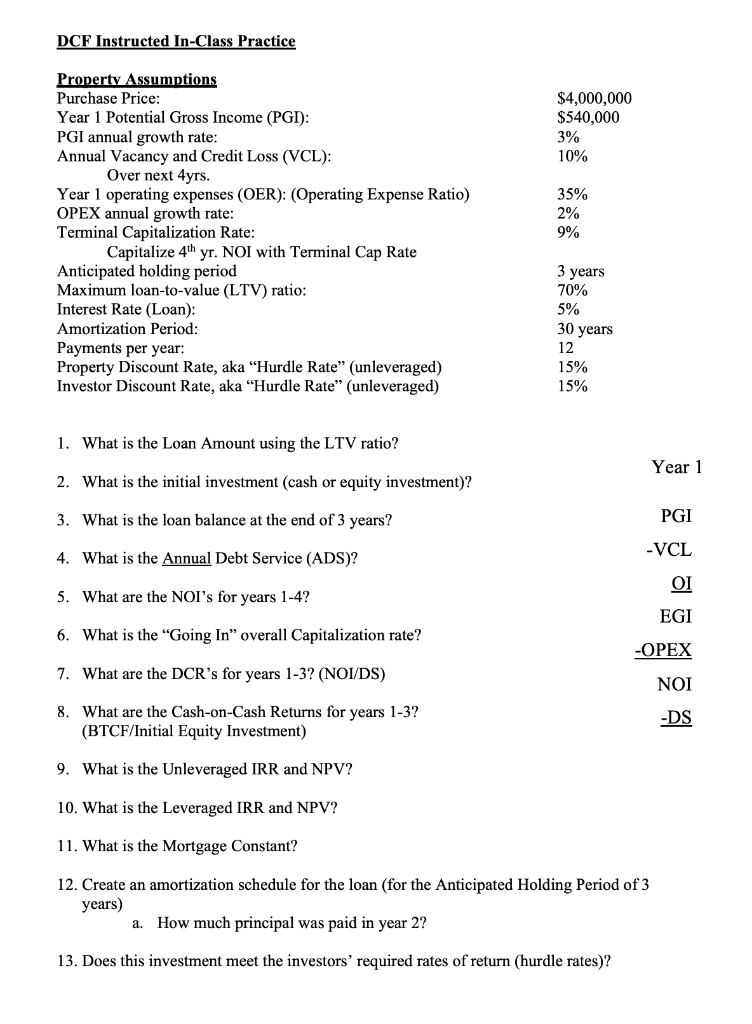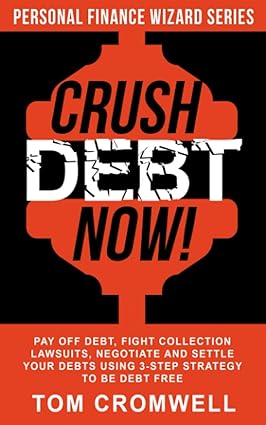
DCF Instructed In-Class Practice $4,000,000 $540,000 3% 10% Property Assumptions Purchase Price: Year 1 Potential Gross Income (PGI): PGI annual growth rate: Annual Vacancy and Credit Loss (VCL): Over next 4yrs. Year 1 operating expenses (OER): (Operating Expense Ratio) OPEX annual growth rate: Terminal Capitalization Rate: Capitalize 4th yr. NOI with Terminal Cap Rate Anticipated holding period Maximum loan-to-value (LTV) ratio: Interest Rate (Loan): Amortization Period: Payments per year: Property Discount Rate, aka "Hurdle Rate (unleveraged) Investor Discount Rate, aka "Hurdle Rate" (unleveraged) 35% 2% 9% 3 years 70% 5% 30 years 12 15% 15% 1. What is the Loan Amount using the LTV ratio? Year 1 2. What is the initial investment (cash or equity investment)? 3. What is the loan balance at the end of 3 years? PGI -VCL 4. What is the Annual Debt Service (ADS)? OI 5. What are the NOI's for years 1-4? EGI 6. What is the "Going In" overall Capitalization rate? -OPEX 7. What are the DCR's for years 1-3? (NOI/DS) NOI 8. What are the Cash-on-Cash Returns for years 1-3? (BTCF/Initial Equity Investment) -DS 9. What is the Unleveraged IRR and NPV? 10. What is the Leveraged IRR and NPV? 11. What is the Mortgage Constant? 12. Create an amortization schedule for the loan (for the Anticipated Holding Period of 3 years) a. How much principal was paid in year 2? 13. Does this investment meet the investors' required rates of return (hurdle rates)? DCF Instructed In-Class Practice $4,000,000 $540,000 3% 10% Property Assumptions Purchase Price: Year 1 Potential Gross Income (PGI): PGI annual growth rate: Annual Vacancy and Credit Loss (VCL): Over next 4yrs. Year 1 operating expenses (OER): (Operating Expense Ratio) OPEX annual growth rate: Terminal Capitalization Rate: Capitalize 4th yr. NOI with Terminal Cap Rate Anticipated holding period Maximum loan-to-value (LTV) ratio: Interest Rate (Loan): Amortization Period: Payments per year: Property Discount Rate, aka "Hurdle Rate (unleveraged) Investor Discount Rate, aka "Hurdle Rate" (unleveraged) 35% 2% 9% 3 years 70% 5% 30 years 12 15% 15% 1. What is the Loan Amount using the LTV ratio? Year 1 2. What is the initial investment (cash or equity investment)? 3. What is the loan balance at the end of 3 years? PGI -VCL 4. What is the Annual Debt Service (ADS)? OI 5. What are the NOI's for years 1-4? EGI 6. What is the "Going In" overall Capitalization rate? -OPEX 7. What are the DCR's for years 1-3? (NOI/DS) NOI 8. What are the Cash-on-Cash Returns for years 1-3? (BTCF/Initial Equity Investment) -DS 9. What is the Unleveraged IRR and NPV? 10. What is the Leveraged IRR and NPV? 11. What is the Mortgage Constant? 12. Create an amortization schedule for the loan (for the Anticipated Holding Period of 3 years) a. How much principal was paid in year 2? 13. Does this investment meet the investors' required rates of return (hurdle rates)







